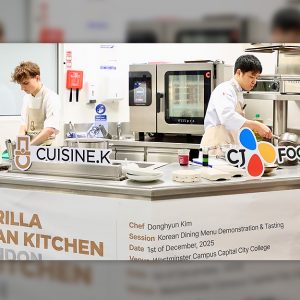This year’s major keywords for cultural food trends have been released: Less Effort (convenience), Individual (personalized), Food Tech and ESG. As COVID-19 becomes a part of our daily lives, such trends are expected to settle in sooner rather than later. In anticipation of these trends, CJ CheilJedang last year harnessed big data technology to analyze and investigate 83,000 diets, 260,000 recipe types and the menus of 4,665 individuals to develop their own 2022 Food Culture Trend Forecast.

This year’s major keywords for cultural food trends have been released, and they are: Less Effort, the Individual, Food Tech and ESG (Sustainability). Last year, CJ CheilJedang harnessed big data technology to analyze and investigate 83,000 diets, 260,000 recipe types and the menus of 4,665 individuals to develop their own 2022 Food Culture Trend Forecast.
The Pursuit for Ultra-Convenience Through Less Hassle: Efficient Meals Prepared at Home
According to CJ CheilJedang’s survey ‘Awareness About Home Meal Replacement (HMR) and Methods of Preparing Meals’, which was conducted last year and involved 1,000 people, 71.9% of the respondents said they had satisfying experiences with HMRs after COVID-19. The number of HMR meals being enjoyed per person also increased, from an annual average of 225.5 meals to 236.5 meals per person, which is 11 in total. Explaining this increase, 57.3% of respondents answered that HMR meals were “convenient to cook and eat”.
“Consumers consider ‘convenience’ to be the most important factor in the process of preparing meals,” said an official from CJ CheilJedang. “The standard of convenience that is expected is increasingly rising, leading to the pursuit of ‘ultra-convenient’ products.”
In response to these changing consumer needs, Next Convenience products, which identify and solve minor inconveniences experienced by consumers during the various phases of meal preparation, are being rolled out in quick succession. Typical examples of Next Convenience products include Bibigo Boneless Grilled Fish, from which fish bones have been removed, and Hetbahn Sotbahn, a rice dish cooked in a hot pot which can be prepared in two minutes using a microwave. As the demand for efficient, home-prepared meals increases, HMRs are evolving in a way that not only reduces the duration of meal preparation, but also saves time spent eating.

The Individual: the Rise of Personalized, Healthy, Functional Food and the Gradual Segmentation of the HMR Market
Another noticeable trend is that of individualization. To be specific, interest in immunity and health care in daily life has grown. Consumers of the Millennial and Generation Z demographic, who are especially proactive in their consumer choices, show a willingness to invest in themselves by pursuing food options that are both practical and healthy.
Furthermore, this year is expected to see an increase in focus on customized markets from food companies and startups. In order to respond to such market changes in advance, CJ CheilJedang made its health business division independent last January. Launched as CJ Wellcare, it plans to develop and release a customized, healthy and practical food brand.
Meal menus for dishes prepared in the home are also becoming more varied. For example, within the Korean market, Western and Chinese meals were previously enjoyed exclusively when eating out, but, through HMR, food delivery and meal kit options, they have now become a daily routine. In fact, the proportion of Korean dishes prepared at home decreased by 1.2% last year, while the ratio of Western and Chinese food served at home increased by an equivalent percentage.
HMRs in particular are rapidly emerging as the best dining option for people who do not have enough time to eat out, but still want to enjoy the broad choices typically available when doing so. In fact, last year’s sales of the Chinese cuisine products of CJ CheilJedang’s convenience food brand ‘Gourmet’ tripled compared to the previous year’s sales volume.

Proportion of meals consumed at home in Korea, excluding Korean dishes
Furthermore, the food industry’s online shopping sites are also expected to strengthen their personalized services, with customized platforms that carefully consider the viewpoints of customers proving increasingly successful. Along this line, subscription services are evolving to reduce shopping time and to recommend items that take into account the preferences of customers in various product areas, such as daily necessities, food and beverages, and lifestyle.
Food Tech: Food Products and Ingredients Based on Eco-friendly Technology Emerge as a Future-Growth Engine
Competition to occupy future growth engines — through research & development and investment — is also set to intensify alongside the rapidly changing food market. Specifically, eco-friendly, technology-based food products and ingredients are expected to form a significant new growth engine for the food industry.
Meat substitutes, cultured meat and eco-friendly seasoning ingredients are good examples of these more sustainable options, many of which incorporate exciting new food technologies. Last year, CJ CheilJedang launched a 100% plant-based and vegan-certified Bibigo PlanTable Mandu and is planning to expand its product lineup this year by developing further meat substitute technologies. Nongshim plans to open a vegan restaurant that offers meals made from vegetable ingredients only, while the SK Group has set up a fund worth 100 billion KRW with hopes of targeting the alternative food market.
According to Euromonitor, the size of the Korean meat substitutes market is forecasted to grow by 15.5 billion KRW, which is an increase of 35% compared to 11.5 billion KRW in 2020, and is expected to exceed 18.1 billion KRW by 2025. The global market, meanwhile, is predicted to reach 7 trillion KRW by 2023, from 4.24 trillion KRW in 2015. Given the fact that the global market has grown nearly 50% in six years, the Korean market is also expected to grow steeply.
Seasoning ingredients designed to enhance taste and flavor that are not subject to artificial processes, like additives and chemical treatments, are also stepping into the spotlight. The natural seasoning ingredient market has recorded an average growth rate of 6-10% per year. CJ CheilJedang’s TasteNrich®, a natural fermented seasoning ingredient, recorded 30 billion KRW sales last year, and received the attention of global companies.
Sustainability (ESG): Environmentally Conscious Products Becoming a Significant Purchase Criterion
While the subject of food has, until recently, seen consumers reflecting principally on their own needs and preferences, nowadays consumers are aware that their eating choices connect them to many meaningful moral topics, and younger people have placed a particular value on ethical and eco-friendly products.
The release of products that are easy to recycle and which display clearly their efforts to reduce plastic use is expected to increase significantly. Major global and domestic food companies have begun to collect the containers used by their customers directly, and efforts are being exerted to decrease superfluous plastic usage, such as minimizing unnecessary plastic trays in product packaging.
Similarly, food upcycling is emerging as a new trend. Eco-friendly products designed to utilize food by-products such as bean-curd dregs and broken rice, which were once considered reasonable discards, are on the rise.
“This year’s cultural food trends, along with the expectation of daily life returning to normal, will involve people taking ever-better care of their health and placing a further emphasis on their wellness and personal preferences,” said Lim Young-ha, one of the heads of CJ CheilJedang’s Trend Insight Team. “Companies and consumers will work together to build a sustainable future, and we will identify rapidly changing consumption trends in advance, continuing to introduce innovative services and products to meet the needs of those trends.”











